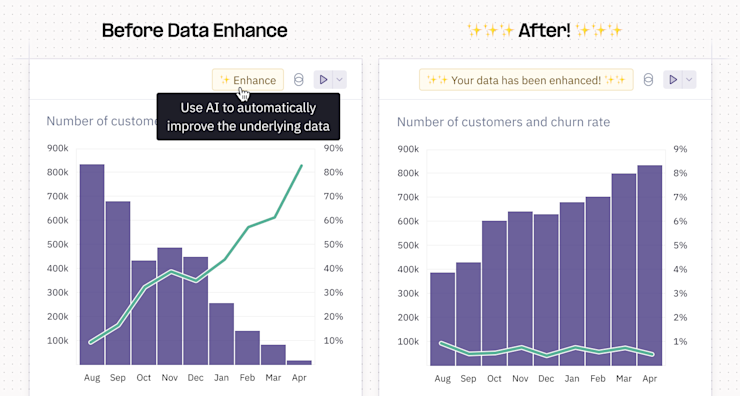
We’ve all been there – you build an analysis and share an insight with a stakeholder, but it underwhelms. The charts are well-formatted but… it’s not quite what they were looking for.

As a data team, you want to make sure stakeholders are happy with the results of your work – and now we’ve made that easier than ever with our new Magic Data Enhance feature.
Simply click “Enhance” on any map or chart, and we will use a state-of the-art agentic AI pipeline to analyze the data, and automatically adjust it to make a better impression.

You can also add more detailed prompting instructions. As an example, "make it so sales start trending up last January", or "start improving retention at the start of last quarter" – your wish is Hex's command!
Revenue chart not hockey-sticking enough for the CEO? Click “Enhance” and they’ll be excited by the change! 📈
Churn spiking up? Magic Enhance will smooth it out and wash the worries away. 📉
Retention troubles? Let Magic Enhance do the trick! 📊
Under the hood with FACADE™
This is all made possible due to cutting-edge AI research from our Magic team, who have built an AI Agent named FACADE™ (Fine-tuned Agent for Creative Adjustment of Data Exposition) to do the task.

There’s 6 simple steps:
We pass the y-axis label to a small, 5B parameter model running in the user’s browser that analyzes and decides whether it’s a positive-positive axis (e.g., Revenue) or positive-negative axis (e.g., Cancellations)
Next, that result is passed to a state-of-the-art reasoning model built by a stealth team of cracked ex-OpenAI interns. This model uses the step 1 result and context about the underlying data, creating a plan for how best to “adjust” to make it better.
That output is then passed to a fine-tuned version of DeepSeek v3, which analyzes that plan and compares it against the analysis done in existing projects in Hex, updating it to fit the standards of your organization.
Now the magic happens: the output of step 3 is then passed to a pre-release version of Claude Sonnet 4.1, which creates a new dataset based on the plan.
Then, that output is passed to the original version of GPT-2 (which we found to somehow have better experimental results) to check and make sure it looks sensible, smoothing out any weird spikes.
Finally, FACADE commits the enhanced data to memory using a custom-built vectorstore, allowing future Magic Enhance runs to pull the results and ensure consistency between runs.
All of this executes on a first-of-it’s kind hybrid NVIDIA / Cerebras cluster built in partnership with Project Stargate, allowing the entire inference pipeline to execute in blazing-fast speeds, often returning results in under 7 minutes.
We're just getting started!
Editing data for presentation is one thing – but sometimes you want to make a more permanent update.
So our team is already hard at work on applying enhancements to the underlying database, and eventually propagate to upstream systems of record as well.
Join the waitlist
For data teams, Magic Enhance can save you hours of work on manual data manipulation, so you and your team can get to the kind of high-ROI work you want to be spending your time on.
And for data consumers, Magic Enhance helps them rest easy, knowing that the metrics look the way they want 🧘♂️
And there’s much more coming soon, including a natural-language interface for stakeholders to request their own data modifications.
We’re onboarding teams to Magic Data Enhance now, if you’re interested please reach out to us at magic at hex dot tech .
If this is is interesting, click below to get started, or to check out opportunities to join our team.